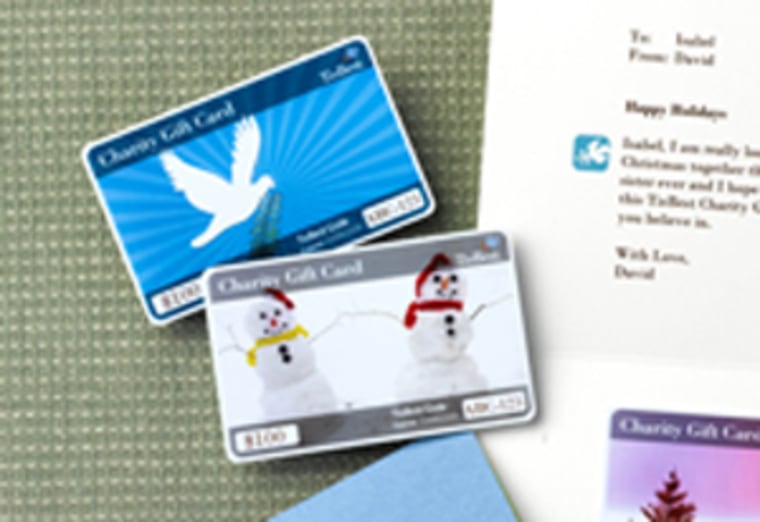There’s a reason why gift cards are so popular this time of year – they fill a need. You don’t have to worry about giving something the recipient doesn’t want or need. You provide the money and they do the shopping.
Charity gift cards take this concept to the next level. You make a charitable donation but the recipient chooses which charity receives it.
“It’s a meaningful gift,” says Joan Barbieri of San Luis Obispo, Calif. “Everyone already has so much stuff and doesn’t need any more.”
Barbieri bought charity gift cards for her boss and family members last Christmas at TisBest.org, a 3-year old Web site based in Seattle. She says everyone really enjoyed getting them. So she’s doing it again this year.
“We don’t want to get rid of gift giving,” says Erik Marks, TisBest’s founder. “But once people get material wealth, giving each other more stuff just doesn’t make a lot of sense.”
The company sold 15,000 charity gift cards last year and expects to more than double that this year. The cards can be loaded with any amount of money (to the penny) between $10 and $5,000. Customers can print the card on their computer, have it sent by e-mail or physically delivered. For standard shipping there is no charge.
TisBest cards never expire, but there is an up front charge. You pay a 3 percent credit card transaction fee (the same as if you made a donation via credit card directly to a charity) and $1.95 to the company. The charity gets all the rest. On a $50 card, the charity receives $46.55.
Recipients can “spend” the TisBest card at 250 national non-profits. About half are familiar names, such as the ASPCA and UNICEF. The rest are what Marks calls “unique charities” that are doing “new, exciting and innovative stuff” but are not high-visibility. These include Girls on the Run, Jacob’s Pillow Dance, and the National Hospice Foundation.
“We were thrilled to be approached by TisBest,” says Susan Messina, the National Hospice Foundation’s director of development communications. “This struck us as a unique, interesting, new and valuable way for people to share the gift of giving.”
Various options
Selling gift cards online for charitable donations is a relatively new concept, but it’s growing. You can now buy them from Charity Navigator, CharityChoice, and Network for Good.
Charity Navigator, which has been around since 2001, is the largest independent evaluator of charitable groups. Marketing director Sandra Miniutti tells me they started offering “good cards” a few years ago because so many people wanted them.
Charity Navigator charges a flat rate of $5 per card. The cards are issued by the Network for Good. The recipient can donate the money on the “good card” to any of the more than one-million charities in the United States.
Gift card critics
The editors at Consumer Reports see a number of drawbacks to charity gift cards – starting with the fees deducted from the donation. They also dislike any card with an expiration date.
And they point out any tax deduction goes to the purchaser, not the recipient. (But let’s be fair – the donor would still get the deduction if he/she gave directly to the charity in your name and you were sent an acknowledgment letter.)
TisBest’s Eric Marks calls Consumer Reports’ criticism unfair. He says writing a check to a charity “gets the job done” but it doesn’t make a good gift. Marks points out that his site has raised more than a million dollars in donations so far.
“The charities love it. They get checks from us quarterly and don’t have to do a thing,” he says.
Daniel Borochoff, president of the American Institute of Philanthropy, a charity watchdog group based in Chicago, doesn’t think charity cards are a bad thing. But he says it’s better to give directly to the charity.
“By dealing with a third party you are taking some risk that you don’t have to take,” Borochoff says. “That money could get diverted or delayed, potential problems that you can easily avoid by going direct.”
Charity Navigator’s Miniutti agrees – it’s always best to cut out the middleman. But she says the demand is there for charity gift cards.
“People want to have something tangible to share with their friends and family and they don’t necessarily like the idea of selecting the charity for them,” she says.
Mercy Corps, an international aid and development organization based in Portland, Ore., gets donations from gift cards. Jacob Colie, the group’s director of public relations, says charity card Web sites “are a good thing” because “they broaden the pie.” He hopes they lead people to start a direct relationship with a charity of their choice.
“That’s going to be more efficient and they’re going to learn more about the cause they’re trying to support,” Colie says.
The bottom line
Charitable contributions were down last year. Many organizations are in desperate need of funds. Anything that encourages more donations is good. And gift cards seem to do that.
The buyer just needs to be mindful of the limitations. If you go this route, choose a card with low fees and I’d suggest, one with no expiration date. (See comparison chart)
If you receive one of these cards you may have the option to donate to a well-known organization or one you’re not familiar with. Even if the Web site provides a list of charities to choose from, don’t assume they’ve been checked out to your satisfaction.
“I still encourage people whenever they make a donation to find out more about the charity,” advises Bennett Weiner, CEO of the Better Business Bureau’s Wise Giving Alliance. “See if they are spending money the way you feel they should be.” One place to do that is on the BBB site.
Most importantly, use the card right away before you lose it or forget about it. Unfortunately, that happens way too often with gift cards of any kind.
